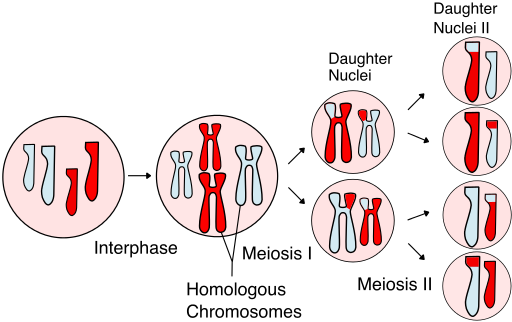Difference between revisions of "Meiosis"
(Created page with "==Key Stage 4== ===Meaning=== Meiosis is the process of asexual reproduction where a parent cell produces four haploid daugh...") |
|||
| (6 intermediate revisions by 2 users not shown) | |||
| Line 2: | Line 2: | ||
===Meaning=== | ===Meaning=== | ||
[[Meiosis]] is the process of [[sexual Reproduction|asexual reproduction]] where a parent [[Cell (Biology)|cell]] produces four [[haploid]] daughter [[Cell (Biology)|cells]] known as [[gamete]]s that are all [[genetically]] unique. | [[Meiosis]] is the process of [[sexual Reproduction|asexual reproduction]] where a parent [[Cell (Biology)|cell]] produces four [[haploid]] daughter [[Cell (Biology)|cells]] known as [[gamete]]s that are all [[genetically]] unique. | ||
| + | |||
| + | [[Noun]]: '''Meiosis''' | ||
| + | |||
| + | [[Adjective]]: '''Meiotic''' | ||
===About Meiosis=== | ===About Meiosis=== | ||
| − | : [[Meiosis]] is how | + | : [[Meiosis]] is how [[multicellular]] [[organism]]s (including [[human]]s) produce [[gamete]]s for [[Sexual Reproduction|sexual reproduction]]. |
| − | : | + | : '''Meiotic [[Cell Division|cell division]]''' results in the production of 4 daughter [[Cell (Biology)|cells]] which are all [[genetically]] different to each other. |
| − | : During [[ | + | : During '''meiotic [[Cell Division|cell division]]''' the [[Cell Nucleus|nucleus]] divides into two separate [[diploid]] [[Cell Nucleus|nuclei]] before dividing a second time to produce 4 [[haploid]] [[Cell Nucleus|nuclei]]. |
: The four daughter [[Cell (Biology)|cells]] are called [[haploid]] [[Cell (Biology)|cells]] because they contain half the number [[chromosome]]s needed to grow a new [[organism]]. | : The four daughter [[Cell (Biology)|cells]] are called [[haploid]] [[Cell (Biology)|cells]] because they contain half the number [[chromosome]]s needed to grow a new [[organism]]. | ||
{| class="wikitable" | {| class="wikitable" | ||
| Line 14: | Line 18: | ||
| style="height:20px; width:200px; text-align:center;" |A [[diagram]] showing the [[chromosome]]s during the process of [[meiosis]]. | | style="height:20px; width:200px; text-align:center;" |A [[diagram]] showing the [[chromosome]]s during the process of [[meiosis]]. | ||
|} | |} | ||
| + | |||
| + | ===References=== | ||
| + | ====AQA==== | ||
| + | |||
| + | :[https://www.amazon.co.uk/gp/product/1782946381/ref=as_li_tl?ie=UTF8&camp=1634&creative=6738&creativeASIN=1782946381&linkCode=as2&tag=nrjc-21&linkId=5ec5fc3f6429e30c1d9ab9bca2bccf93 ''Meiosis, page 208, GCSE Combined Science Trilogy; Biology, CGP, AQA ''] | ||
| + | :[https://www.amazon.co.uk/gp/product/1782945954/ref=as_li_tl?ie=UTF8&camp=1634&creative=6738&creativeASIN=1782945954&linkCode=as2&tag=nrjc-21&linkId=100574c08fbbb64318256eb79ed61a76 ''Meiosis, page 253, GCSE Biology, CGP, AQA ''] | ||
| + | :[https://www.amazon.co.uk/gp/product/1782945598/ref=as_li_tl?ie=UTF8&camp=1634&creative=6738&creativeASIN=1782945598&linkCode=as2&tag=nrjc-21&linkId=ad276ad49df77ab4b40ab4fd0fe10065 ''Meiosis, page 68, GCSE Combined Science; The Revision Guide, CGP, AQA ''] | ||
| + | :[https://www.amazon.co.uk/gp/product/1782945563/ref=as_li_tl?ie=UTF8&camp=1634&creative=6738&creativeASIN=1782945563&linkCode=as2&tag=nrjc-21&linkId=9a1d023a374038e6072f33c4f3cf808b ''Meiosis, page 88, GCSE Biology; The Revision Guide, CGP, AQA ''] | ||
| + | :[https://www.amazon.co.uk/gp/product/1471851338/ref=as_li_tl?ie=UTF8&camp=1634&creative=6738&creativeASIN=1471851338&linkCode=as2&tag=nrjc-21&linkId=425855d5890466e47189e1c21b67a1ea ''Meiosis, pages 180-2, GCSE Biology, Hodder, AQA ''] | ||
| + | :[https://www.amazon.co.uk/gp/product/0198359373/ref=as_li_tl?ie=UTF8&camp=1634&creative=6738&creativeASIN=0198359373&linkCode=as2&tag=nrjc-21&linkId=952a73bbb09d222ecc4b50d200679849 ''Meiosis, pages 196, 198-199, 201, GCSE Biology; Third Edition, Oxford University Press, AQA ''] | ||
| + | :[https://www.amazon.co.uk/gp/product/1471851362/ref=as_li_tl?ie=UTF8&camp=1634&creative=6738&creativeASIN=1471851362&linkCode=as2&tag=nrjc-21&linkId=7d78d70a2044ee9982dae010c94af92a ''Meiosis, pages 30-1, GCSE Combined Science Trilogy 2, Hodder, AQA ''] | ||
| + | :[https://www.amazon.co.uk/gp/product/1471851362/ref=as_li_tl?ie=UTF8&camp=1634&creative=6738&creativeASIN=1471851362&linkCode=as2&tag=nrjc-21&linkId=7d78d70a2044ee9982dae010c94af92a ''Meiosis; Comparison with mitosis, pages 32, GCSE Combined Science Trilogy 2, Hodder, AQA ''] | ||
| + | :[https://www.amazon.co.uk/gp/product/1471851362/ref=as_li_tl?ie=UTF8&camp=1634&creative=6738&creativeASIN=1471851362&linkCode=as2&tag=nrjc-21&linkId=7d78d70a2044ee9982dae010c94af92a ''Meiosis; How it produces variation, pages 32, GCSE Combined Science Trilogy 2, Hodder, AQA ''] | ||
| + | |||
| + | ====Edexcel==== | ||
| + | |||
| + | :[https://www.amazon.co.uk/gp/product/1782945741/ref=as_li_tl?ie=UTF8&camp=1634&creative=6738&creativeASIN=1782945741&linkCode=as2&tag=nrjc-21&linkId=30da4f2178da182547b62a7329d13b57 ''Meiosis, page 26, GCSE Combined Science; The Revision Guide, CGP, Edexcel ''] | ||
| + | :[https://www.amazon.co.uk/gp/product/1782946748/ref=as_li_tl?ie=UTF8&camp=1634&creative=6738&creativeASIN=1782946748&linkCode=as2&tag=nrjc-21&linkId=a4f0348fc37d0ba1bb52d27f8679581f ''Meiosis, page 32, GCSE Biology; The Revision Guide, CGP, Edexcel ''] | ||
| + | :[https://www.amazon.co.uk/gp/product/1782948120/ref=as_li_tl?ie=UTF8&camp=1634&creative=6738&creativeASIN=1782948120&linkCode=as2&tag=nrjc-21&linkId=dedef775c6a43dbb0a609441525adac0 ''Meiosis, page 85, GCSE Biology, CGP, Edexcel ''] | ||
| + | :[https://www.amazon.co.uk/gp/product/1292120193/ref=as_li_tl?ie=UTF8&camp=1634&creative=6738&creativeASIN=1292120193&linkCode=as2&tag=nrjc-21&linkId=572df39392fb4200db8391d98ae6314e ''Meiosis, pages 40-41, GCSE Combined Science, Pearson Edexcel ''] | ||
| + | :[https://www.amazon.co.uk/gp/product/1292120207/ref=as_li_tl?ie=UTF8&camp=1634&creative=6738&creativeASIN=1292120207&linkCode=as2&tag=nrjc-21&linkId=22455ff53961978667722edaa64c0be5 ''Meiosis, pages 52-53, GCSE Biology, Pearson, Edexcel ''] | ||
| + | |||
| + | ====OCR==== | ||
| + | :[https://www.amazon.co.uk/gp/product/1782945695/ref=as_li_tl?ie=UTF8&camp=1634&creative=6738&creativeASIN=1782945695&linkCode=as2&tag=nrjc-21&linkId=ceafcc80bcad6b6754ee97a0c7ceea53 ''Meiosis, page 50, Gateway GCSE Combined Science; The Revision Guide, CGP, OCR ''] | ||
| + | :[https://www.amazon.co.uk/gp/product/1782945660/ref=as_li_tl?ie=UTF8&camp=1634&creative=6738&creativeASIN=1782945660&linkCode=as2&tag=nrjc-21&linkId=83aa4500ad7759e7f401a1c5ba5df758 ''Meiosis, page 68, Gateway GCSE Biology; The Revision Guide, CGP, OCR ''] | ||
| + | :[https://www.amazon.co.uk/gp/product/0198359810/ref=as_li_tl?ie=UTF8&camp=1634&creative=6738&creativeASIN=0198359810&linkCode=as2&tag=nrjc-21&linkId=d768d99f1a06f7c12fab40e5aef85a55 ''Meiosis, pages 154-155, Gateway GCSE Biology, Oxford, OCR ''] | ||
Latest revision as of 10:18, 14 December 2019
Contents
Key Stage 4
Meaning
Meiosis is the process of asexual reproduction where a parent cell produces four haploid daughter cells known as gametes that are all genetically unique.
Noun: Meiosis
Adjective: Meiotic
About Meiosis
- Meiosis is how multicellular organisms (including humans) produce gametes for sexual reproduction.
- Meiotic cell division results in the production of 4 daughter cells which are all genetically different to each other.
- During meiotic cell division the nucleus divides into two separate diploid nuclei before dividing a second time to produce 4 haploid nuclei.
- The four daughter cells are called haploid cells because they contain half the number chromosomes needed to grow a new organism.
| A diagram showing the chromosomes during the process of meiosis. |
References
AQA
- Meiosis, page 208, GCSE Combined Science Trilogy; Biology, CGP, AQA
- Meiosis, page 253, GCSE Biology, CGP, AQA
- Meiosis, page 68, GCSE Combined Science; The Revision Guide, CGP, AQA
- Meiosis, page 88, GCSE Biology; The Revision Guide, CGP, AQA
- Meiosis, pages 180-2, GCSE Biology, Hodder, AQA
- Meiosis, pages 196, 198-199, 201, GCSE Biology; Third Edition, Oxford University Press, AQA
- Meiosis, pages 30-1, GCSE Combined Science Trilogy 2, Hodder, AQA
- Meiosis; Comparison with mitosis, pages 32, GCSE Combined Science Trilogy 2, Hodder, AQA
- Meiosis; How it produces variation, pages 32, GCSE Combined Science Trilogy 2, Hodder, AQA
Edexcel
- Meiosis, page 26, GCSE Combined Science; The Revision Guide, CGP, Edexcel
- Meiosis, page 32, GCSE Biology; The Revision Guide, CGP, Edexcel
- Meiosis, page 85, GCSE Biology, CGP, Edexcel
- Meiosis, pages 40-41, GCSE Combined Science, Pearson Edexcel
- Meiosis, pages 52-53, GCSE Biology, Pearson, Edexcel
